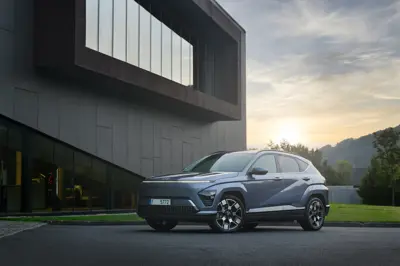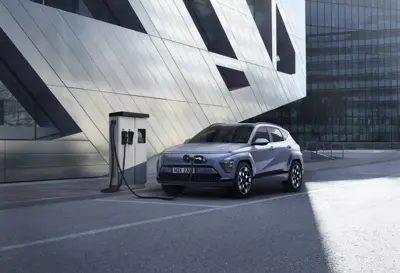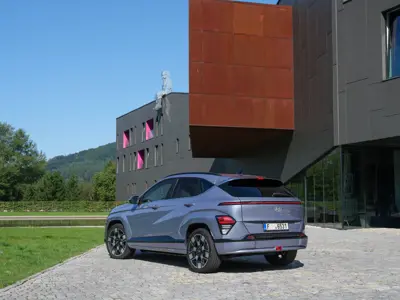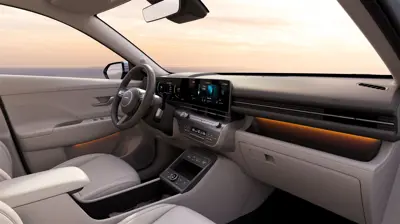Hyundai Kona Standard Range
The Hyundai Kona Standard Range is an all-electric crossover offering a WLTP range of up to 377 km (234 miles). EVKX.net has all the details you need.
Hyundai Kona Standard Range
We've organized this article into specific sections for easier navigation. Click the links below to jump to different areas or read on for the full article. Additionally, we offer an overview of the full specifications, an image gallery, detailed information about charging performance, and some online reviews. Our sections include:
Performance
The Hyundai Kona Standard Range offers modest performance with a maximum power of 160 kW (218 hp / 215 bhp) and a total torque of 255 Nm (188 lb-ft). It accelerates from 0 to 100 km/h (0 to 62 mph) in 7.3 seconds and has a top speed of 185 km/h (115 mph), aligning more closely with traditional internal combustion engine vehicles.
Hyundai Kona Standard Range
Battery, Range, and Charging
The high-capacity battery has a gross capacity of 51.0 kWh and a net usable capacity of 48.4 kWh, providing a 2.6 kWh buffer (5.1%) for battery protection.
According to the WLTP (Worldwide Harmonized Light Vehicles Test Procedure) standard, the vehicle's range is 377 km (234 miles), with an energy consumption rate of 12.8 kWh/100 km (3 mi/kWh).
For more details about the range, see real-world data and range listings on this model’s range and consumption page.
The vehicle supports fast DC charging with a maximum power of 100 kW. Charging from 0% to 100% takes approximately 55 minutes, while a typical 10% to 80% charge takes about 28 minutes with an average charging speed of 73 kW.
Considering an additional 5 minutes for each charging stop due to driving interruptions, the optimal charging range is from 4% to 65%. This results in an effective charging speed, including time lost, of 64 kW, with each charging session taking about 28 minutes and 51 seconds.
In a 1000 km challenge at a constant speed of 120 km/h (75 mph) with an assumed consumption rate of 23 kWh/100 km, the trip would take about 11 hours and 12 minutes, needing six charging stops from 4% to 67%, totaling 173 minutes of charging time.
Onboard Charger
The standard onboard charger supports up to 11 kW for Level 1 and Level 2 AC charging, allowing a full 0–100% charge in about 4 hours and 23 minutes with a standard home setup.
Charge Port
The location of the charge port is on the front. This location makes it easy to use charge stations where you need to park with the front in.
Connector types vary by market: this model uses CCS Combo 1 in North America and CCS Combo 2 in Europe. For complete specifications for all markets, refer to the full specifications.
Drivetrain
The Hyundai Kona Standard Range has a front-wheel drive system supported by one motor on the front axle.
Suspension
The suspension has a fixed height and damping characteristics.
Ground clearance with this setup is 178 mm.
Brakes
Regenerative Braking
Regenerative braking is available in two modes. You can use one-pedal driving or you can coast and use the blended brakes to regen.
The system stops the car completely using friction brakes.Exterior
The Hyundai Kona Standard Range, with dimensions of 4355 mm in length, 1825 mm in width, and 1575 mm in height, falls into the B-SUV segment cars, also known as subcompact SUVs or crossovers, offer a combination of the compact size and maneuverability of B-segment cars with the higher driving position, increased cargo space, and rugged styling of an SUV.
The Hyundai Kona Standard Range offers a selection of 21 paint colors, featuring solid, metallic, pearlescent, and matte options.
The Hyundai Kona Standard Range offers multiple wheel options in different sizes, allowing you to customize your vehicle to suit your style and driving preferences. The available tire and wheel combinations include:
- 215/60 tires on 17" rims
- 235/45 tires on 19" rims
Narrower wheels improve consumption and provide a longer range, while wider wheels offer better traction and handling.
The car has four regular doors and a hatchback-style liftgate.
There are two different roof options to select from.
The standard is just a regular roof.
As an option, you can order this model with a sunroof. The glass extends over only the front row, and occupants can open it. This glass makes the car’s interior feel more spacious and bright, which can improve the mood and comfort of the occupant. It has an electric curtain that occupants can use to protect against the sun.
Additionally, you can order the car with tinted windows from the B-pillar backward, which enhances privacy and reduces glare and heat from the sun, making the interior more comfortable for passengers.
Hyundai Kona Standard Range
Interior
You can choose between different types of seat materials and interior styling.
You can choose between several interior designs.
Seats
The Hyundai Kona Standard Range accommodates five passengers with two front seats and a three-seat bench in the rear.
First Row Seats
The Hyundai Kona Standard Range offers a single type of front seat.
The following functionalities are available on the standard seat:
- Fore-and-aft adjustment (manually adjustable, electrically adjustable as an option)
- Recline adjustment (manually adjustable, electrically adjustable as an option)
- Height adjustable headrest
- Heating
- Memory (standard for driver, not available for passenger)
- Adjustable lumbar support (electrically adjustable)
- Ventilation (optional)
Available in:
Second Row Seat
The second row features a standard three-seat bench with a 40:20:40 split, allowing each section to fold separately to increase cargo space.
Additional functionalities include:
- Recline adjustment (manually adjustable)
- Heating (standard for outer seats)
Hyundai Kona Standard Range
Climate System
There is one climate system available:
- 2-zone climate system: Supports different temperatures for the driver and passenger.
This model has a heat pump as an option. This heat pump can save significant energy used for heating in cold weather.
Comfort Features
The Hyundai Kona Standard Range includes several features to enhance comfort and convenience:
- Wireless Phone Charging
User Interface and Control
This model features a dual-screen setup integrated into a shared horizontal frame on the dashboard, clearly separating driver and infotainment functions while maintaining a unified visual design.
Key screen details:
- Driver Information Display: A 12.3-inch screen positioned behind the steering wheel on the left side of the shared dashboard frame. It provides essential driving data such as speed, range, and navigation prompts.
- Infotainment Screen: A 12.3-inch touchscreen located on the right side of the same shared frame. It serves as the main interface for infotainment, navigation, and vehicle settings.
A optional head-up display projects key driving information—such as speed and navigation cues—onto the windshield for enhanced safety and convenience.
Hyundai Kona Standard Range
Steering Wheel
The Hyundai Kona Standard Range is equipped with a single type of steering wheel:
- Circular Steering Wheel: This steering wheel features optional integrated heating for added comfort during cold weather. It also provides intuitive control over the infotainment system, allowing you to easily adjust the volume, change music tracks, and manage other key functions.
Mirrors
Both the exterior and interior mirrors use conventional mirror technology to provide a clear view of the area behind the vehicle.
Infotainment
Navigation System
With the common.standardfeature in-car navigation system, you have all the assistance you need to reach your destination effortlessly.
Phone Mirroring
The Hyundai Kona Standard Range supports Android Auto and Apple CarPlay, allowing you to mirror your phone's screen on the car's display. This functionality enables you to run apps like Google Maps or Waze directly from your phone.
Sound System
The Hyundai Kona Standard Range comes equipped with one sound system option:
- Bose Premium Sound System: Features seven speakers.
Additionally, the model includes 4 USB-C connections as standard.
Mobile App
The Hyundai Kona Standard Range comes with a dedicated mobile app, available for both Android and iOS devices, allowing you to manage and monitor your vehicle remotely. The app offers a wide range of features designed to enhance your driving experience:
Lights
Standard Headlights: These use advanced LED technology, providing bright and efficient illumination.
The taillights use LED technology, ensuring both high visibility and energy efficiency.
Hyundai Kona Standard Range
Advanced Driver Assistance Systems
The Hyundai Kona Standard Range features a range of standard and optional advanced driver assistance systems (ADAS) designed to enhance safety and comfort.
Safety Systems
Anti-lock Braking System (ABS): Standard on the Hyundai Kona Standard Range, this system prevents the wheels from locking during braking.
Electronic Stability Control (ESC): Standard on the Hyundai Kona Standard Range, this system improves the vehicle's stability and handling during sudden maneuvers or on slippery road conditions.
Lane-Keeping Assist (LKA): Standard on the Hyundai Kona Standard Range, this system helps prevent the vehicle from drifting out of its lane.
It also includes a Lane Departure Warning system to alert the driver if the vehicle veers out of the lane.
Front Cross Traffic Assist (FCTA) : Standard on the Hyundai Kona Standard Range, this driver assist system that helps drivers detect oncoming traffic when crossing an intersection or turning left or right from a stopped position.
Rear Cross Traffic Alert (RCTA): Standard on the Hyundai Kona Standard Range, this system uses sensors to detect approaching vehicles from the side when backing out of a parking space or driveway.
Forward Collision Warning (FCW): Standard on the Hyundai Kona Standard Range, this driver assist system helps drivers avoid or mitigate frontal collisions.
Automatic Emergency Braking (AEB): Standard on the Hyundai Kona Standard Range, this system autonomously applies the brakes to prevent or reduce the severity of a collision if the driver does not react in time.
Automatic Emergency Steering (AES): Standard on the Hyundai Kona Standard Range, this system assists in avoiding collisions by automatically steering the vehicle in an emergency.
Blind-spot Monitoring (BSM) : Standard on the Hyundai Kona Standard Range, this side assist system helps to detect traffic in blind spots.
Driving Automation
With the standard level 2 system, you get the following driving automation features.
- Adaptive Cruise Control (ACC)
- Lane Centering Assist (LCA) /AutoSteer: keeps the car in your lane and slows down if needed in traffic. The system limits how long you can drive without touching the steering wheel.
- Automatic parking.
- Automatic Lane Change (ALC)
Safety
Security and Access Technologies
The Hyundai Kona Standard Range is equipped with advanced security features to protect you and your vehicle. These include:
- Keyless Entry and Start: The vehicle's keyless entry and start system enables seamless access, allowing you to unlock and start the car without needing to remove the key from your pocket or bag.
Cargo Capacity and Towing Ability
The trunk offers a cargo capacity of 466 liters (16.5 CU FT). With the rear seat folded down, this expands to 1578 liters (55.7 CU FT).
On the roof, you can load up to 100 kg (220.5 lbs).
Roof rails are standard for easy mounting of a roof box or rack.
Additionally, there is a frunk (front trunk) with a storage capacity of 27 liters (1.0 CU FT).
The vehicle’s maximum weight is 2110 kg (4652 lbs), with a base weight of 1640 kg (3616 lbs). This allows for a maximum load of 470 kg (1036 lbs), including the driver and passengers. Note that some options may increase the base weight and reduce the maximum loading capacity.
A towbar can be added to the vehicle. The maximum permissible weight for a braked trailer is 750 kg (1653 lbs), while for an unbraked trailer, it is 750 kg (1653 lbs).






